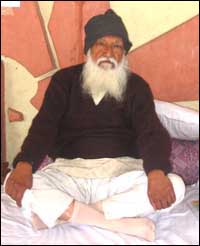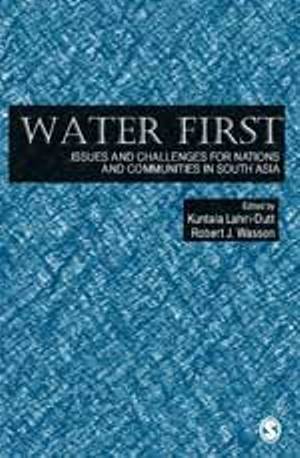/topics/society-culture-religion-and-history
Society, Culture, Religion and History
Protesting broken promises: Dr. G.D. Agrawal resumes fast-unto-death
Posted on 20 Jan, 2009 12:19 PM
Images of a dying river, handwritten Press releases & more: Images of a Struggle on Flickr Charging the Government of India with not keeping its solemn commitment to keep the River Bhagirathi alive in its pristine stretch from Gangotri to Uttarkashi, Dr. G.D. Agrawal has resumed his fast-unto-death from Makar Sankranti Day, Wednesday, Jan 14, 2009.
You may recall that Prof. G. D Agrawal, former Professor & Dean of Students at IIT-Kanpur, the first Member-Secretary of India's Central PollutionControl Board and one of India's foremost environmental scientists went on a fast from June 13, 2008 to seek uninterrupted flow of River Bhagirathi (Ganga) in its natural form between Gangotri and Uttarkashi. His demand was very limited & specific, i.e., that the River Ganga be allowed to flow in its natural form in this 125 km stretch from its origin. This is the only stretch left now where the Ganga can still be seen in its pristine form. Dr. Agrawal requested the Govt. of India & the State Govt. of Uttarakhand to stop construction of Hydro Electric Projects (HEPs) in this stretch so that river flow was not diverted through tunnels that would destroy its ecology and its unique self-purifying properties. (diagrams are provided in the attached press release). Indians across the world got sensitized and lent their support to Prof Agrawal. Many wrote or met the PM of India and the CM of Uttarakhand and requested them to protect the Holy Ganga , whom Pandit Jawaharlal Nehru described as India's civilizational identity.
Old wells at the Konark Sun Temple, Orissa
Posted on 08 Dec, 2008 09:21 AMBoth Mohenjo daro and Harappa reported wells in every household and also community wells. They are perhaps the oldest in the subcontinent. Here is one open well from the Konark temple in Orissa. These must have been the sole providers of good clean water during that time and one of them continues to provide water for the repair work underway.
Blog action day -- Water and poverty
Posted on 15 Oct, 2008 10:24 PMToday is Blog Action Day 2008, where blogs all over the world are writing about poverty. We thought we would use this opportunity to talk about water and poverty.
Book shelf : "Water First: Issues and Challenges for Nations and Communities in South Asia" by Kuntala Lahiri-Dutt and Robert J Wasson
Posted on 29 Sep, 2008 10:11 AM This book brings together current knowledge and cutting edge interdisciplinary perspectives from renowned scholars on the histories, politi
This book brings together current knowledge and cutting edge interdisciplinary perspectives from renowned scholars on the histories, politi
On the book shelf: Interlinking of Rivers in India, Issues and Concerns
Posted on 31 Aug, 2008 10:26 AM Key Features: Reviews the risks of inter-basin water transfers warns of critical disadvantages with India's proposed ILR plan offers viable less-risky solutions for water resource development. Inter-basin water transfers are complex human interventions on natural systems that can have profound adverse as well as beneficial social, economic and environmental implications. India's plan to interlink its rivers (ILR) and to transfer water may, according to one set of views, generate positive benefits through improved and expanded irrigation and may also contribute to flood and drought hazards mitigation for India, although the magnitudes are debatable. However, there are opposing views, in the context of India itself, that the interlinking plan is economically prohibitive, fraught with uncertainties, and has potential for disastrous and irreversible adverse after-effects. Water deficit can be reduced through improved water management without large scale engineering interventions. Moreover many of the rivers involved, particularly in the Himalayan component, are international and, therefore, the scheme has major implications for other riparians. Indeed, the planned transfer of water from the Ganges and Brahmaputra rivers will adversely impact Bangladesh socially, economically and environmentally---unless arrangements are made to maintain historical flows, which is unlikely to be feasible.
Key Features: Reviews the risks of inter-basin water transfers warns of critical disadvantages with India's proposed ILR plan offers viable less-risky solutions for water resource development. Inter-basin water transfers are complex human interventions on natural systems that can have profound adverse as well as beneficial social, economic and environmental implications. India's plan to interlink its rivers (ILR) and to transfer water may, according to one set of views, generate positive benefits through improved and expanded irrigation and may also contribute to flood and drought hazards mitigation for India, although the magnitudes are debatable. However, there are opposing views, in the context of India itself, that the interlinking plan is economically prohibitive, fraught with uncertainties, and has potential for disastrous and irreversible adverse after-effects. Water deficit can be reduced through improved water management without large scale engineering interventions. Moreover many of the rivers involved, particularly in the Himalayan component, are international and, therefore, the scheme has major implications for other riparians. Indeed, the planned transfer of water from the Ganges and Brahmaputra rivers will adversely impact Bangladesh socially, economically and environmentally---unless arrangements are made to maintain historical flows, which is unlikely to be feasible.
High Level Expert Group on the Bhagirathi river lacks required expertise
Posted on 28 Aug, 2008 10:05 PMAll is not well with the High Level Expert Group (HLEG) constituted on an order of the Government of India to determine the flow required to keep the Bhagirathi river 'alive and to ensure perennial environmental flow in the river'. It may be recalled that on June 30, 2008 the Government of India committed itself to "suitably ensure perennial environmental flow in all stretches of river Bhagirathi."This commitment was made in response to a representation of the Alumini Association of IIT- Kanpur to the Prime Minister of India requesting his intervention in the fast-unto-death undertaken by Dr. G.D. Agrawal , a former Dean of IIT-Kanpur -- to ensure the natural and uninterrupted flow of the Bhagirathi river between Gangotri and Dharasu (Uttarkashi). Subsequently the Ministry of Power, GoI, directed Shri R.S. Sharma, Chairman & Managing Director of NTPC, to constitute a high level expert group. The biggest problem with the HLEG is that it lacks the necessary scientific expertise to comprehensively address the issue. In a letter to Shri R.S. Sharma, rejecting his invitation to be a member of the HLEG, Dr G.D. Agrawal wrote, "Several members of the HLEG as constituted (including its Chairman) fall extremely short on any sort of expertise on river ecology and environmental flows...The commitment of most proposed members towards conservation of Bhagirathi Gangaji as the mother of India's faith, unity and culture is also questionable and I cannot afford to provide credibility to its deliberations and conclusions by being an ordinary member of the group."
KRAPAVIS:Reviving "Orans" physically and conceptually
Posted on 13 Aug, 2008 04:39 AMOrans are local micro bio-diversity reserves- community conserved areas (CCAs) harboring the shrine of a local goddess or deity. Also known as Dev-banis, these local forests vary in size from a hundred to five hundred bighas (about hundred hectares). Most Orans have sources of water, either small springs or rivulets running through them or a variety of ponds and nadis in their midst.
Open painting competition on "Proper Sanitation and Safe Water", 2 May 2008
Posted on 22 Jun, 2008 06:10 AMAn Open Painting Competition on the theme "PROPER SANITATION AND SAFE WATER"held on Sunday the 25th May, 2008, by Arghyam & YVU, Thoubal.
Call for abstracts by SOPPECOM Forum for Policy Dialogue on Water Conflicts in India, 18-20 Dec 2008, Srilanka
Posted on 21 Jun, 2008 01:31 AM Forwarded to the Portal by: Shruti, SOPPECOM Forum for Policy Dialogue on Water Conflicts in India invites abstracts for papers on "Contending Water Uses and Users and Inter-Sectoral Equity in South Asia: Cases and Learnings for a New Policy,
Forwarded to the Portal by: Shruti, SOPPECOM Forum for Policy Dialogue on Water Conflicts in India invites abstracts for papers on "Contending Water Uses and Users and Inter-Sectoral Equity in South Asia: Cases and Learnings for a New Policy,





